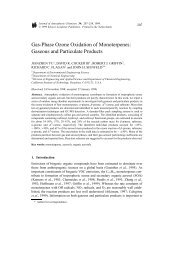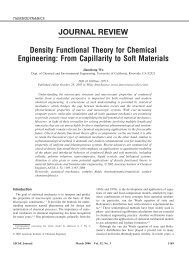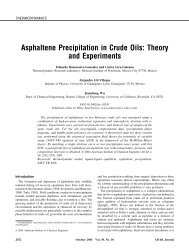DEVELOPMENT OF REVISED SAPRC AROMATICS MECHANISMS
DEVELOPMENT OF REVISED SAPRC AROMATICS MECHANISMS
DEVELOPMENT OF REVISED SAPRC AROMATICS MECHANISMS
Create successful ePaper yourself
Turn your PDF publications into a flip-book with our unique Google optimized e-Paper software.
photolysis and OH radical reaction. Therefore, the O 3 reactions were deleted in the updated mechanism.<br />
As shown on Table 2, this is the only revision made to the AFG1 and AFG2 mechanisms.<br />
Non-Photoreactive Products. The model species AFG3 is used to represent the reactions of<br />
uncharacterized non-photoreactive ring fragmentation products, which are assumed to be primarily<br />
diunsaturated dicarbonyls. In <strong>SAPRC</strong>-07 AFG3 is also used for monounsaturated 1,4-diketones predicted<br />
to be formed from the reactions of alkylbenzenes with substituents in the para position, but in the updated<br />
mechanism a separate model species, AFG4, is used for this purpose. Both of these types of compounds<br />
are assumed to be relatively unreactive with respect to photolysis, and thus are represented separate model<br />
species from AFG1 and AFG2 discussed above. The mechanism for AFG3 is based on those estimated<br />
for the representative diunsaturated dicarbonyl products 3-methyl 2,4-hexadien-1,6-dial (40.5%), 6-oxo-<br />
2,4-heptadienal (53.7%), and 3,5-octadien-2,7-dione (5.8%). 2 The weighting factors used are based on<br />
estimated diunsaturated dicarbonyls for toluene and the di- and tri-methylbenzene isomers, each weighed<br />
equally, with 2,4-hexadien-1,6-dial representing all dialdehydes, 6-oxo-2,4-heptadienal representing<br />
aldehyde-ketones, and 3,5-octadien-2,7-dione representing the diketones. The estimated mechanisms for<br />
monounsaturated diketones were not taken into account because they are not predicted to be formed from<br />
the majority of aromatics. The AFG3 mechanism was not revised for this update, though it is included in<br />
Table 2 for completeness.<br />
Since the monounsaturated diketones are expected to have different mechanisms and form<br />
different products than the diunsaturated species used to derive the mechanism for AFG3, for this version<br />
of the mechanism a separate model species, AFG4, was added to represent only the monounsaturated 1,4-<br />
diketones. The mechanism for AFG3 was not revised because it was based on neglecting the contributions<br />
of these monounsaturated diketone compounds. The only significant net loss process for these AFG4<br />
compounds is assumed to be reaction with OH radicals, and its mechanism was estimated using the<br />
<strong>SAPRC</strong>-07 mechanism generation system, based on the structure for cis-3-hexene-2,5-dione. The rate<br />
constant is from Tuazon et al (1985), as recommended by Calvert et al (2002). The model species xAFG4<br />
is added to represent the formation of AFG4 following reactions of peroxy radicals with NO (Carter,<br />
2010a,b), and the model species xAFG3 is removed because the diunsaturated dicarbonyls are not<br />
assumed to be formed following peroxy radical reactions.<br />
Revised Mechanisms for Phenolic Compounds<br />
Because of their importance for aromatic SOA formation as discussed by Carter et al (2012), an<br />
effort was made in this project to improve the representation of phenolic products such as phenols, cresols<br />
(methyl phenols), xylenols (dimethyl phenols), and catechols (dihydroxy benzenes). In <strong>SAPRC</strong>-07 the<br />
model species CRES is used to represent all these compounds, and a parameterized mechanism was<br />
developed based on environmental chamber model simulations of a single, relatively high concentration<br />
(~0.5 ppm NO x ) o-cresol - NO x chamber experiment carried out in 1978 in the <strong>SAPRC</strong> evacuable<br />
chamber (EC281). Because of their expected importance for SOA formation, for this project a number of<br />
new chamber experiments have been carried out with cresols and other representative phenolic<br />
compounds, and the results are poorly simulated by the <strong>SAPRC</strong>-07 mechanism that was adjusted to fit the<br />
data for EC281. Therefore, revised mechanisms for phenolic compounds were developed for this work.<br />
The first revision was that separate model species are used to represent reactions of phenol<br />
(PHEN), cresols (CRES), xylenols and other higher molecular weight alkyl phenols (XYNL), and<br />
catechols (CATL) predicted to be formed in the reactions of the phenolic products. These are represented<br />
2 Note that the documentation given in Carter (2010a,b) had incorrect contribution factors that exceeded<br />
100%. The factors given here are those that were actually used, which correctly add to 100%.<br />
28
















